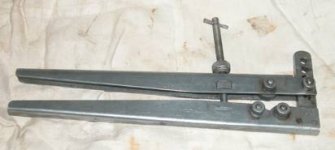Dave K2
Stainless
- Joined
- Apr 18, 2007
- Location
- Hertfordshire, England
Hi all,
I have a possible repeat batch-job coming up but need to knurl around 75mm of an 8mm shaft.
I had a try this morning as not really done any before , i have a clamp type tool and tried the fitted wheels first, these were the medium of the three provided but although it did cut, one of the wheels was bored off-centre (yeah i know, crap tool) and the little lathe was not happy, it started off bad but cut in the end, this is the right-hand of the two in the picture.
, i have a clamp type tool and tried the fitted wheels first, these were the medium of the three provided but although it did cut, one of the wheels was bored off-centre (yeah i know, crap tool) and the little lathe was not happy, it started off bad but cut in the end, this is the right-hand of the two in the picture.

Then i changed to the coarse wheels and they ran better but now i get a double-cut on one angle?? (left image)
Is there a secret to knurling i need to learn? Does feed-rate matter, can i expect to knurl 3" / 75mm in one hit with no tail support?
Any tips ?
Thanks
I have a possible repeat batch-job coming up but need to knurl around 75mm of an 8mm shaft.
I had a try this morning as not really done any before
 , i have a clamp type tool and tried the fitted wheels first, these were the medium of the three provided but although it did cut, one of the wheels was bored off-centre (yeah i know, crap tool) and the little lathe was not happy, it started off bad but cut in the end, this is the right-hand of the two in the picture.
, i have a clamp type tool and tried the fitted wheels first, these were the medium of the three provided but although it did cut, one of the wheels was bored off-centre (yeah i know, crap tool) and the little lathe was not happy, it started off bad but cut in the end, this is the right-hand of the two in the picture.
Then i changed to the coarse wheels and they ran better but now i get a double-cut on one angle?? (left image)
Is there a secret to knurling i need to learn? Does feed-rate matter, can i expect to knurl 3" / 75mm in one hit with no tail support?
Any tips ?
Thanks






